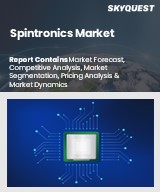
Report ID: SQMIG45N2115
SkyQuest Technology's Spintronics market size, share and forecast Report is based on the analysis of market data and Industry trends impacting the global Spintronics Market and the revenue of top companies operating in it. Market Size Data and Statistics are based on the comprehensive research by our Team of Analysts and Industry experts.
Global Spintronics Market size was valued at USD 1.78 Billion in 2023 and is poised to grow from USD 2.07 Billion in 2024 to USD 6.88 Billion by 2032, growing at a CAGR of 16.2% during the forecast period (2025-2032).
The spintronics Market is experiencing a drastic shift, led by the confluence of memory device technology progress, increased need for quicker data processing, and rising emphasis on energy-efficient electronics. Spintronics, particularly with its use in magneto resistive random-access memory (MRAM) is undergoing increasinG adoption of data centers, automotive electronics, and consumer electronics. Specifically, hyperscale cloud providers and enterprise data centers are looking for memory technologies that provide low power, high endurance, and high speed—a domain where spintronic-based MRAM excels compared to legacy flash memory and DRAM. Furthermore, the recent global deployment of 5G and edge computing has stepped up the demand for memory and logic systems that have higher throughput without consuming more power, leading to spintronics becoming a plausible substitute in embedded and IoT applications.
Is Spintronics the Future Backbone of AI, Defense, and Green Electronics?
The trend of miniaturization in consumer electronics is generating robust interest in spin-based logic gates and quantum spintronic devices that have the potential to provide non-volatile computing at nanoscale levels. As the semiconductor industry is moving towards heterogeneous integration—integrating memory, logic, and sensors onto a single chip—spintronics is turning out to be a disruptive technology, particularly for neuromorphic and AI hardware. Despite difficulties such as CMOS integration and material prices, industry giants such as Intel, IBM, and Samsung are increasing reserach and devlopments. Spintronics is also finding favor among aerospace and defense for its resilience to radiation. With growing deployment across cloud, automotive, and industrial applications, the market holds out for big-bang innovations in the offing.
Why Is Energy-Efficient Memory the Key to Spintronics Market Growth?
With exponentially increasing data requirements and escalating energy prices, spintronic memory technologies such as MRAM and STT-MRAM are gaining popularity for their low power consumption and non-volatility. These memory solutions are well suited for edge devices, AI chips, and wearables requiring both efficiency and performance. With data centers—the largest consumers of electricity at 1–2% of the world's total electricity consumption—also looking to adopt greener options, spintronics is an environmentally friendly alternative. Their resistance to billions of write cycles also positions them perfectly for automotive and industrial applications. With governments and businesses focusing on carbon-neutral operations, energy-efficient spintronics is stepping forward as a prime driver of green computing architectures.
REQUEST FOR SAMPLE
Global Spintronics Market size was valued at USD 1.78 Billion in 2023 and is poised to grow from USD 2.07 Billion in 2024 to USD 6.88 Billion by 2032, growing at a CAGR of 16.2% during the forecast period (2025-2032).
The global spintronics market is really driven by companies investing a lot into research and development, along with new tech breakthroughs. Big names like IBM, Intel, and Samsung are all trying to stay ahead by pushing out innovative ideas. For example, IBM has made impressive progress in quantum computing by using spintronic materials to make better qubits, especially by tapping into the quantum spin Hall effect. Likewise, Intel is working on spin-based transistors as part of their long-term plan to bring spintronics into regular computing. These companies are also especially focused on developing spin-based memory solutions like STT-MRAM, which they see as key for automotive tech and AI applications—aiming to lead the way in next-generation memory technologies. Samsung has been channeling investments into spintronic memory and locking in strategic patents to protect their innovations. Partnerships help companies boost their manufacturing capacity, solve issues related to scaling up, and lower the costs of devices. By working together with startups and universities big players are trying to push the limits of what spintronics can do, all while positioning themselves at the forefront of the quantum and AI revolutions. 'IBM Corporation', 'Intel Corporation', 'Everspin Technologies', 'Samsung Electronics', 'NVE Corporation', 'QuantumWise A/S', 'Infineon Technologies AG', 'SpintronicsAI', 'Taiwan Semiconductor Mfg Co Ltd', 'Commissariat Energie Atomique'
What Makes Asia Pacific a Leader in Spintronics?
Want to customize this report? This report can be personalized according to your needs. Our analysts and industry experts will work directly with you to understand your requirements and provide you with customized data in a short amount of time. We offer $1000 worth of FREE customization at the time of purchase.
Feedback From Our Clients

Report ID: SQMIG45N2115
sales@skyquestt.com
USA +1 351-333-4748